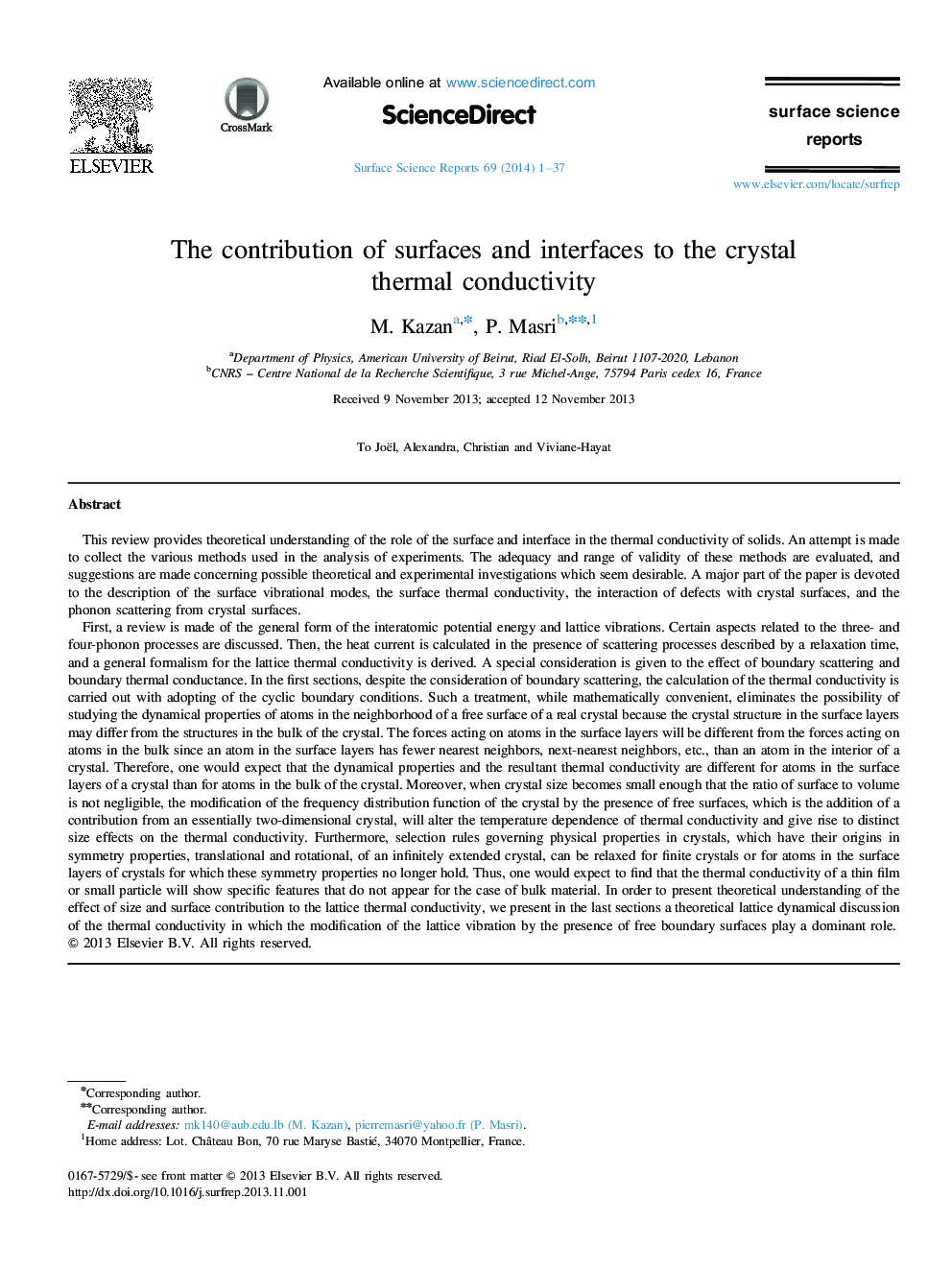| کد مقاله | کد نشریه | سال انتشار | مقاله انگلیسی | نسخه تمام متن |
|---|---|---|---|---|
| 7845151 | 1508428 | 2014 | 37 صفحه PDF | دانلود رایگان |
عنوان انگلیسی مقاله ISI
The contribution of surfaces and interfaces to the crystal thermal conductivity
ترجمه فارسی عنوان
سهم سطوح و اتصالات در هدایت حرارتی بلوری
دانلود مقاله + سفارش ترجمه
دانلود مقاله ISI انگلیسی
رایگان برای ایرانیان
ترجمه چکیده
ابتدا بررسی کلی از شکل کلی انرژی بالقوه تعادلی و ارتعاشات شبکه انجام شده است. برخی جنبه های مربوط به فرایندهای سه و چهار فونون مورد بحث قرار می گیرند. سپس، جریان گرما در حضور فرآیند پراکندگی توصیف شده با زمان آرام سازی محاسبه می شود و یک فرمول رسم عمومی برای هدایت حرارتی شبکه حاصل می شود. توجه خاص به تاثیر پراکندگی مرزی و هدایت حرارتی مرزی است. در بخش های اول، با وجود توجه به پراکندگی مرزی، محاسبه هدایت حرارتی با اتخاذ شرایط مرزی چرخه ای انجام می شود. چنین درمان، در حالی که از لحاظ ریاضی راحت است، امکان مطالعه خواص دینامیکی اتم ها را در محدوده ی یک سطح آزاد از یک بلور واقعی را از بین می برد، زیرا ساختار بلوری در لایه های سطح ممکن است با ساختارهای عمده کریستال متفاوت باشد. نیروهایی که بر روی اتمها در لایه های سطحی عمل می کنند متفاوت از نیروهایی هستند که بر روی اتم ها در انبوه عمل می کنند، زیرا اتم در لایه های سطحی دارای نزدیکترین همسایگان کم، نزدیکترین همسایگان و غیره، نسبت به یک اتم در داخل یک کریستال . بنابراین انتظار می رود که خواص دینامیکی و هدایت حرارتی حاصل از آن برای اتم ها در لایه های سطحی یک کریستال متفاوت از اتم های بزرگ در کریستال باشد. علاوه بر این، هنگامی که اندازه کریستال به اندازه کافی کوچک می شود که نسبت سطح به حجم ناسازگار نیست، تغییر تابع توزیع فرکانس کریستال با حضور سطوح آزاد است که علاوه بر سهم از یک بلور عمدتا دو بعدی ، وابستگی دمای هدایت حرارتی را تغییر خواهد داد و باعث ایجاد اثرات متمایز اندازه بر هدایت حرارتی خواهد شد. علاوه بر این، قوانین انتخاب خصوصیات فیزیکی در بلورها که منشأ آنها در خصوص خواص تقارنی، انتقال و چرخشی از یک بلور بی نهایت توسعه یافته است، می تواند برای بلورهای محدود یا برای اتم ها در لایه های سطحی بلورها که برای این خواص خواص متقارن دیگر نگه دارید بنابراین انتظار می رود که هدایت حرارتی یک فیلم نازک یا ذرات کوچک ویژگی های خاصی را نشان دهد که در مورد مواد فله ای ظاهر نمی شود. به منظور ارائه درک نظری از اثر اندازه و سهم سطح به هدایت حرارتی شبکه، در آخرین بخش ارائه یک بحث نظری شبکه پویا از هدایت حرارتی که در آن اصلاح ارتعاش شبکه با حضور سطوح مرزی آزاد نقش مهمی بازی کند
موضوعات مرتبط
مهندسی و علوم پایه
شیمی
شیمی تئوریک و عملی
چکیده انگلیسی
First, a review is made of the general form of the interatomic potential energy and lattice vibrations. Certain aspects related to the three- and four-phonon processes are discussed. Then, the heat current is calculated in the presence of scattering processes described by a relaxation time, and a general formalism for the lattice thermal conductivity is derived. A special consideration is given to the effect of boundary scattering and boundary thermal conductance. In the first sections, despite the consideration of boundary scattering, the calculation of the thermal conductivity is carried out with adopting of the cyclic boundary conditions. Such a treatment, while mathematically convenient, eliminates the possibility of studying the dynamical properties of atoms in the neighborhood of a free surface of a real crystal because the crystal structure in the surface layers may differ from the structures in the bulk of the crystal. The forces acting on atoms in the surface layers will be different from the forces acting on atoms in the bulk since an atom in the surface layers has fewer nearest neighbors, next-nearest neighbors, etc., than an atom in the interior of a crystal. Therefore, one would expect that the dynamical properties and the resultant thermal conductivity are different for atoms in the surface layers of a crystal than for atoms in the bulk of the crystal. Moreover, when crystal size becomes small enough that the ratio of surface to volume is not negligible, the modification of the frequency distribution function of the crystal by the presence of free surfaces, which is the addition of a contribution from an essentially two-dimensional crystal, will alter the temperature dependence of thermal conductivity and give rise to distinct size effects on the thermal conductivity. Furthermore, selection rules governing physical properties in crystals, which have their origins in symmetry properties, translational and rotational, of an infinitely extended crystal, can be relaxed for finite crystals or for atoms in the surface layers of crystals for which these symmetry properties no longer hold. Thus, one would expect to find that the thermal conductivity of a thin film or small particle will show specific features that do not appear for the case of bulk material. In order to present theoretical understanding of the effect of size and surface contribution to the lattice thermal conductivity, we present in the last sections a theoretical lattice dynamical discussion of the thermal conductivity in which the modification of the lattice vibration by the presence of free boundary surfaces play a dominant role.
ناشر
Database: Elsevier - ScienceDirect (ساینس دایرکت)
Journal: Surface Science Reports - Volume 69, Issue 1, 1 March 2014, Pages 1-37
Journal: Surface Science Reports - Volume 69, Issue 1, 1 March 2014, Pages 1-37
نویسندگان
M. Kazan, P. Masri,
